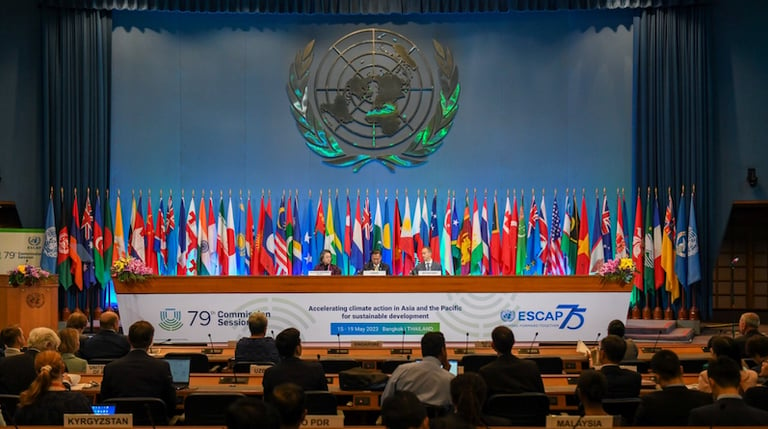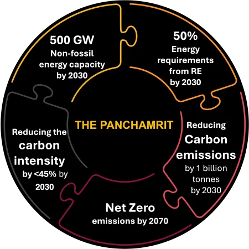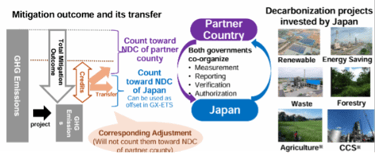Asia’s Dynamic Decarbonization – From Industrial Giants to Emerging Economies
Asia is a region of profound climate contrasts. It is home to both highly industrialized nations with decades of technological advancement and rapidly developing economies, where energy demand is soaring. For the Paris Agreement to succeed, the collective climate action of Asian nations is paramount. This article examines the paths of India, Japan, and South Korea, tracking their progress over the last decade and assessing their future alignment with the 1.5°C goal.
MOST RECENTENERGY POLICY
Aadesh Aslekar
10/27/20257 min read


India: Balancing Growth with Green Ambition
As the world's most populous nation, India's trajectory is defined by the dual imperative of lifting vast populations out of poverty while pursuing a green energy path.
Actions Taken (2015-2025): India's initial NDC focused on reducing the emissions intensity of its GDP by 33–35% compared to 2005 levels and increasing its non-fossil fuel to 40% electricity capacity. The nation has pursued an aggressive rollout of solar and wind power, achieving significant milestones ahead of schedule. Key policy drives include the launch of the International Solar Alliance (ISA) and large-scale, reverse-auction tenders for renewable energy projects, which drove down costs. Its energy policy has been a balancing act, continuing to rely on coal for baseline power while accelerating renewables.
Current Status (2025): India submitted an updated NDC at COP27, committing to reduce the emissions intensity of its GDP by 45% by 2030 (from 2005 levels) and to achieve 50% of its cumulative electric power installed capacity from non-fossil fuel sources by 2030. As of September 2024, India's installed solar capacity stands at approximately 90.76 GW, having increased 30-fold over the past nine years. The National Institute of Solar Energy estimates India's solar potential at 748 GW. The nation is largely on track to meet these intensity and capacity targets.
India's ambitious renewable energy goals, mainly its target of achieving 500 GW of non-fossil fuel-based energy by 2030, align closely with the ISA's mission to drive solar energy adoption worldwide. This goal is part of the broader Panchamrit Initiative, which aims to reduce carbon emissions and promote sustainable development
However, due to its rapid economic growth, total absolute emissions are projected to continue rising well into the next decade.


The Five Commitments (PANCHAMRIT):
1. Achieving 500 GW of non-fossil fuel energy capacity by 2030.
2. Generating 50% of energy requirements from renewable energy by 2030.
3. Reducing total projected carbon emissions by 1 billion tonnes by 2030.
4. Lowering the carbon intensity of the economy by over 45% by 2030 (from 2005 levels).
5. Achieving Net Zero carbon emissions by 2070.
Future Plans: India's long-term goal is Net-Zero by 2070. The focus is on massive renewable energy deployment (especially solar), the development of green hydrogen, and expanding public transport. Promoting the adaptation in urban design, energy and material efficiency in buildings, and sustainable urbanisation, enhancing forest and vegetation cover consistent with socioeconomic and ecological considerations, and the development of carbon dioxide removal and related engineering solutions is key. Promoting economy-wide decoupling of growth from emissions and the development of an efficient, innovative low-emission industrial system is necessary.
The core challenge is securing the estimated trillions of dollars in climate finance and technology transfers required to transition its rapidly growing energy infrastructure away from coal.
Japan: Technology, Nuclear, and Energy Security
Japan represents a highly industrialized nation grappling with the legacy of its post-Fukushima energy mix and a high-stakes bet on cutting-edge technology.
Actions Taken (2015-2025): Following the Paris Agreement, Japan increased its climate ambition, declaring a target of 46% GHG emission reduction by 2030 (from 2013 levels) and committing to Net-Zero by 2050. The key policy driver has been the development of the Green Growth Strategy, which prioritizes major investment in areas like hydrogen, carbon capture and storage (CCS), and offshore wind also aims to create a positive cycle of economic growth and environmental protection, together with the business community. In July 2018, over 100 Japanese companies, local governments, research institutions, and NGOs established the Japan Climate Initiative (JCI), and the membership has increased to more than 6 times as of today. JCI is a network committed to strengthening communication and exchange of strategies and solutions among all actors that are implementing climate actions in Japan. The nation has also slowly revisited its reliance on nuclear power to diversify its energy mix away from fossil fuels.
Current Status (2025): Japan currently aims to supply electricity from 36–38% renewable electricity, 20–22% nuclear, 20% gas, and 19% coal in 2030. Japan has established and implemented the Joint Crediting Mechanism (JCM) in order to quantitatively evaluate the contributions of Japan to greenhouse gas emission reductions and removals which are achieved through the diffusion of, among others, decarbonizing technologies, products, systems, services, and infrastructures as well as through the implementation of measures in global south countries and others, and to use such contributions to achieve Japan’s NDC.


Future Plans: Japan's future is defined by its commitment to the 2050 Net-Zero goal, driven by technological advancements. Its strategy relies heavily on the full implementation of the Green Growth Strategy, aiming for 30-40% “thermal energy” in 2040, the restart and build-out of its nuclear fleet, and securing global supply chains for green hydrogen and ammonia.


South Korea: From Coal Dependency to a Green Partnership
Like Japan, South Korea is a major industrialized power facing energy security challenges and a massive transition away from coal-fired power.
Actions Taken (2015-2025): South Korea's initial NDCs were criticized for being insufficiently ambitious. However, the nation dramatically strengthened its commitment, passing the Framework Act on Carbon Neutrality, which legally enshrines a Net-Zero by 2050 target that is backed up by unprecedented green investment packages. It also submitted an updated NDC to reduce emissions by 40% below 2018 levels by 2030, a significant improvement. Key mechanisms include an existing Emissions Trading System (ETS) and a new policy push for a Green New Deal focused on renewable energy, smart grids, and green infrastructure.
Current Status (2025): South Korea is focusing on the implementation of its Net-Zero roadmap. The Ministry of Environment announced additional measures to increase liquidity in the market, which entered effect in February 2025:
Opening the ETS to a wider group of financial institutions
Laying the foundations for individuals to participate in the market
Revisions of some criteria for market stabilization measures
Tightening of the regulations for cancelling emission allowances by raising the threshold for allowance cancellation from 50% to 15% of the allocation
While its 2030 target is strong, the country's continued reliance on fossil fuels, particularly coal for a large share of its energy, means its current policies are still rated as "insufficient" to align with the 1.5°C Paris goal.
Future Plans: The government is focused on expanding its ETS, accelerating the adoption of electric vehicles, and investing heavily in the manufacturing of clean technologies. The 2050 Carbon Neutrality and Green Growth Committee will be established under the jurisdiction of the President to deliberate and decide on the Government’s key policies, plans, and implementation thereof for the transition to a carbon-neutral society and promotion of green growth. The success of its 2030 target hinges on its ability to rapidly phase out coal power and successfully implement its hydrogen and carbon-free energy strategies.
Conclusion
The Asian continent’s commitment to the Paris Agreement is a narrative of immense contrasts and colossal scale. The paths of Japan and South Korea demonstrate the technical and financial struggles of established industrial powers trying to retrofit their economies, often relying on ambitious technology bets and politically fraught nuclear power. Conversely, the journey of India showcases the monumental challenge of meeting surging energy demand for development while simultaneously attempting a green leapfrog from coal.
Ultimately, Asia’s story is defined by its sheer size and fossil fuel reliance. The successes of its advanced economies are critical, but the trajectories of its emerging giants and their ability to secure the necessary finance and technology will be the decisive factor in determining whether the global community can successfully close the emissions gap and keep the 1.5°C goal within reach.
References:
India on Track to Exceed 2030 NDC Target on CO₂ Emission Reduction
Press Release:Press Information Bureau
What Does India’s Journey to 2070 Net-zero Target Look Like? CEEW Q&A
Roadmap-to-India-2030-Decarbonization-Target.pdf
Energy transition: India’s journey to net zero
Net Zero Emissions Target - Mission Innovation India
Paris Agreement could help India see 30 fewer hot days every year: Study - The Economic Times
Microsoft Word - V5 NDC submission to UNFCCC
India only G20 member to meet commitments of Paris agreement on environment, says Modi - CNBC TV18
Cautious ambition: India’s progress on meeting its international climate commitments, ETEnergyworld
https://isolaralliance.org/about/background https://www.mea.gov.in/Speeches-Statements.htm?dtl/29601
https://pib.gov.in/PressNoteDetails.aspx?NoteId=152130&ModuleId=3®=3&lang=1 https://www.investindia.gov.in/sector/renewable-energy https://pib.gov.in/PressReleasePage.aspx?PRID=2065532 https://sansad.in/getFile/annex/257/AU529.pdf?source=pqars
Japan Climate Initiative – JCI
Recent Developments and Progress for the JCM
Greenhouse Gas Inventory Office|Top Page|National Institute for Environmental Studies
Climate Change Adaptation: Approaches for National and Local Governments
https://gggi.org/wp-content/uploads/2021/01/Koreas-Green-Transition-and-Technology-Strengths.pdf
Statutes of the Republic of Korea
2023_IETA_BizBrief_SouthKorea_V2.pdf
Korea Emissions Trading System (K-ETS) | International Carbon Action Partnership
Korea’s Emissions Trading System: Regulation or Perk?
South Korea's Green New Deal in the year of transition | United Nations Development Programme
Energy Outlook of Carbon Neutrality in 2050
Connect
info@energizetomorrowus.com
© 2025. All rights reserved.


